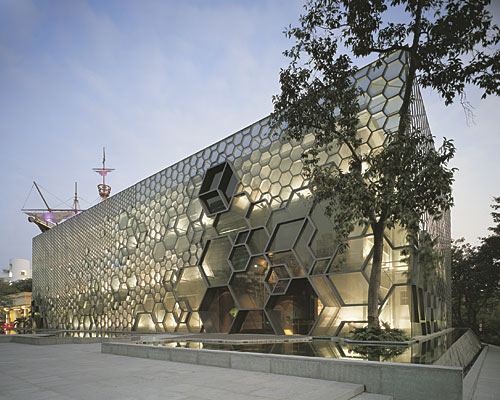China Awards 2010: OCT Art & Design Gallery
Best Public Project

Photo © Johansen Krause

Photo © Johansen Krause

Photo © Johansen Krause



Architects & Firms
Shenzhen, China
“Every city is looking for a facelift”, states Wang Hui, a principal of Urbanus Architects, while talking about his firm’s OCT Art & Design Gallery in Shenzhen. Wang and his partners know that updating both the form and function of an existing building can change the urban fabric around it. In a place like Shenzhen, which has only recently begun to develop a meaningful cultural and artistic scene, such creative adaptations can make particularly important contributions. So Urbanus, which has its own office nearby, applied this knowledge to the job of transforming an outdated laundry facility into an art institution.
The architects wrapped the exterior of the existing structure, a simple box-like building, in a glass curtain-wall featuring hexagonal window frames. The modern building technology and geometric vocabulary update the visual landscape in the area, setting a contemporary agenda. However, the most effective part of the design may be the 2,900-square-meter interior, where three-dimensional hexagonal volumes jut into the galleries, frame entrances and windows, and offer variation and depth to the spaces, as well an unexpected flow of both light and movement. Urbanus brought the language of the exterior inside, and in so doing, achieved a sense of unity and definition. The design of the interior represents a break from traditional gallery spaces, offering a progressive perspective on the practice of exhibiting art and design.
Context is important to the design’s effectiveness, since the building lies between a recently built, unremarkable chain hotel on one side (with an oddly kitschy, full-scale, pirate ship in a public square in front of it), and a decidedly Modernist museum on another. So in order to assert itself as a force for renewal, the OCT gallery needed to stand as a strictly contemporary object, unhampered by precedent or any established tradition.
In Shenzhen especially, where development occurs rapidly and on a grand scale, good business means setting an example. “Our projects are not big,” says Wang. “But small things can have big agendas. They are part of a strategic proposal to the city to set models for changing the worst things into attractive places,” says Wang.






